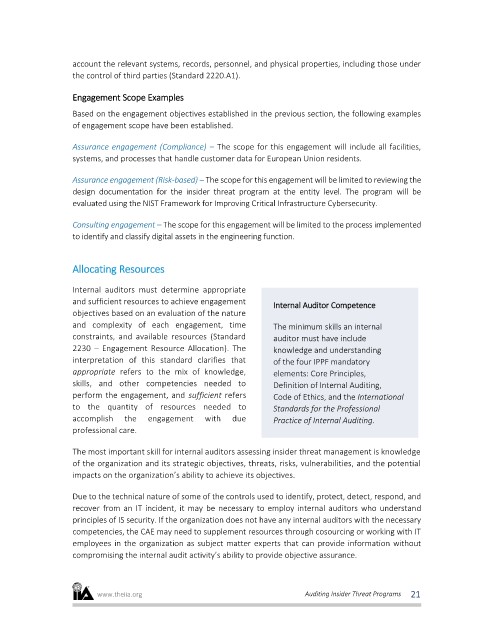Page 389 - ITGC_Audit Guides
P. 389
account the relevant systems, records, personnel, and physical properties, including those under
the control of third parties (Standard 2220.A1).
Engagement Scope Examples
Based on the engagement objectives established in the previous section, the following examples
of engagement scope have been established.
Assurance engagement (Compliance) – The scope for this engagement will include all facilities,
systems, and processes that handle customer data for European Union residents.
Assurance engagement (Risk-based) – The scope for this engagement will be limited to reviewing the
design documentation for the insider threat program at the entity level. The program will be
evaluated using the NIST Framework for Improving Critical Infrastructure Cybersecurity.
Consulting engagement – The scope for this engagement will be limited to the process implemented
to identify and classify digital assets in the engineering function.
Allocating Resources
Internal auditors must determine appropriate
and sufficient resources to achieve engagement
Internal Auditor Competence
objectives based on an evaluation of the nature
and complexity of each engagement, time The minimum skills an internal
constraints, and available resources (Standard auditor must have include
2230 – Engagement Resource Allocation). The knowledge and understanding
interpretation of this standard clarifies that of the four IPPF mandatory
appropriate refers to the mix of knowledge, elements: Core Principles,
skills, and other competencies needed to Definition of Internal Auditing,
perform the engagement, and sufficient refers Code of Ethics, and the International
to the quantity of resources needed to Standards for the Professional
accomplish the engagement with due Practice of Internal Auditing.
professional care.
The most important skill for internal auditors assessing insider threat management is knowledge
of the organization and its strategic objectives, threats, risks, vulnerabilities, and the potential
impacts on the organization’s ability to achieve its objectives.
Due to the technical nature of some of the controls used to identify, protect, detect, respond, and
recover from an IT incident, it may be necessary to employ internal auditors who understand
principles of IS security. If the organization does not have any internal auditors with the necessary
competencies, the CAE may need to supplement resources through cosourcing or working with IT
employees in the organization as subject matter experts that can provide information without
compromising the internal audit activity’s ability to provide objective assurance.
www.theiia.org Auditing Insider Threat Programs 21

